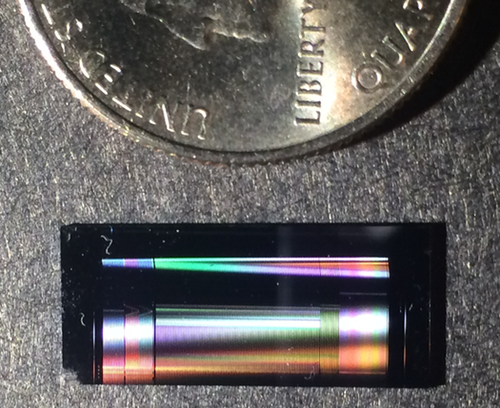Chip Changes Photon Color While Preserving Quantumness
A new device-on-a-chip converts visible light to infrared wavelengths in a way that preserves the quantum states of the photons. This microscopic structure can be produced in large numbers on a single chip. The visible photons to be converted could be the delicate data bits from a quantum computer that need to be transmitted long distances over infrared-friendly fiber-optic cables. The device consists of a tiny ring of semiconductor (called a microring) that, when hit with intense infrared laser light, causes visible photons in the ring to convert to infrared. Together, many microrings on a chip could enable easy conversion of the large numbers of photons that a future quantum computer might need to transmit.
Quantum computing promises super-fast calculations from manipulations of the quantum qualities of atoms or other quantum objects. Visible wavelengths of light are often used to probe and transmit quantum bits over short distances, but long distance transmission over fiber-optic cables works best with infrared wavelengths greater than 1500 nanometers (called “telecom” wavelengths). Transmitting photons in delicate quantum states may be essential in future quantum computing networks. Researchers have previously transmitted quantum information over long distances with optical fibers—for example in so-called teleportation experiments—but they used millimeter- or centimeter-scale crystals. These crystals cannot be combined in large numbers (“scaled up”) to handle the multiple visible wavelengths that quantum computing will require.
Hong Tang and his colleagues at Yale University have now developed a chip-based wavelength converter that can be scaled up. They fabricated it from aluminum nitride (AlN), a common material used in smartphone touchscreens. The team created a 60-micrometer-diameter microring resonator, essentially an AlN light-wave “track” (waveguide) bent into a circle. The structure allows specific wavelengths to circulate for relatively long times. Microring resonators are not new but haven't been used for this type of frequency conversion. Tang and his colleagues designed their ring to support three different wavelengths—one nearly visible (773 nanometers) and two in the telecom range (1538 and 1556 nanometers).
AlN is a material that supports so-called difference frequency generation. With two light frequencies present, a third light field, whose frequency is the difference of the first two, can also appear. The team chose their wavelengths so that one of the telecom frequencies is the difference frequency generated by the other two wavelengths.
The researchers sent in laser light at 1556 and 773 nanometers using connected waveguides and detected 1538-nanometer light produced by difference frequency generation. They showed that when the power of the telecom laser reached about 24 milliwatts, the conversion efficiency—the ratio of the number of output photons to the number of input photons—reached its maximum of 0.14 and then decreased at higher powers. They found similar results for the reverse process (sum frequency generation), where the two telecom wavelengths combine to produce 773-nanometer light. These data agreed with their theoretical predictions.
The team reports that there are several improvements to their setup that will increase the conversion efficiency. But they also note that their relatively high intrinsic conversion rate, which is related to “strong coupling” among the photons of different wavelengths, has never been observed in a scalable device.
Team member and graduate student Xiang Guo says that the device could have additional uses, such as in all-optical control, a process where one light beam controls another, allowing for faster communication. The AlN chip could also be used as an on-chip isolator, a device that blocks light from traveling back into a laser as it reflects off a mirror.
“Before this, strong coupling was huge and expensive,” says Michal Lipson of Columbia University in New York. “With this device, one could imagine a very small chip with lots of functionality, including not just data communication, but also spectroscopy and sensing.” And the low cost could make it widely available, she says.
This research is published in Physical Review Letters.
–Eran Moore Rea
Eran Moore Rea is the science writing intern at APS.





